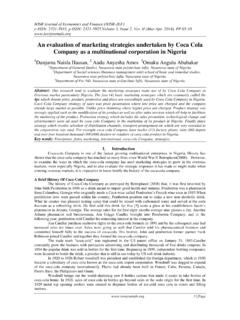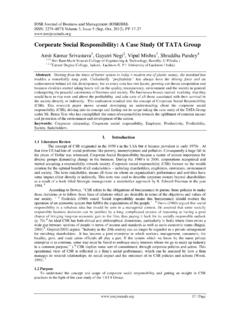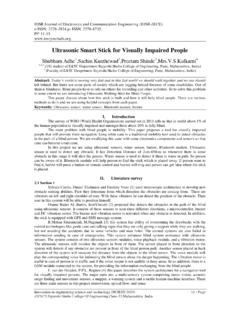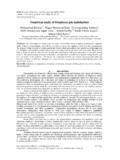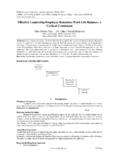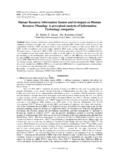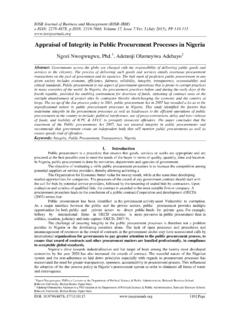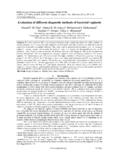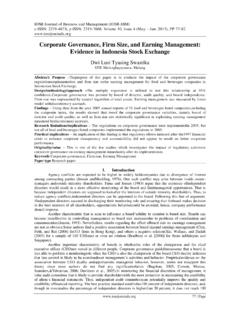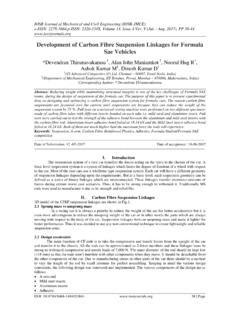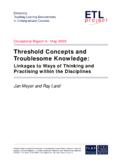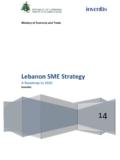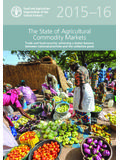Transcription of INCENTIVE SCHEMES, EMPLOYEE MOTIVATION AND …
1 IOSR Journal of Business and Management (IOSRJBM) ISSN: 2278-487X Volume 1, Issue 4 (July-Aug. 2012), PP 32-39 32 | Page INCENTIVE schemes , EMPLOYEE MOTIVATION and productivity In Organizations In Nigeria: Analytical linkages *Dr. Ugwu Ude and **Dr. M. A. Coker Institute of Public Policy and Administration University of Calabar, cross River state, Nigeria Abstract: The paper aims at determining the link between INCENTIVE schemes and EMPLOYEE MOTIVATION and productivity in organizations and to provide useful information to management on how best to design and administer INCENTIVE schemes .
2 To achieve this objective, the paper draws largely from past research findings and cases from the United Nations development Programme (UNDP). Cases cited include those from Tanzania, Rwanda and Brazil. The findings were that INCENTIVE schemes have high significant relationship with EMPLOYEE MOTIVATION and productivity in both the organized private sector and public sector organizations in Nigeria. The paper recommends that management must identify the type of INCENTIVE that best motivate the EMPLOYEE , design and administer flexible INCENTIVE programmes, seek and obtain feedback on incentives and set effective EMPLOYEE performance goals in the organization.
3 Keywords: INCENTIVE schemes , MOTIVATION , EMPLOYEE productivity , reinforcement, analytical linkages , material incentives , and non-material incentives . I. Introduction Employees occupy a strategic role and position in any organization. They are responsible for converting inputs to productive outputs. Since they are the key to the productive outputs, they ought to be effectively and adequately compensated for their labour. Taking cues first from the Biblical expression that a labourer deserves his wages; and secondly bearing in mind that the reward for labour, a factor of production is wages , it becomes logical that employees be adequately and fairly compensated if they are to be motivated to increase productivity in any organization be it the organized private sector or public sector.
4 Drucker (1980:230) believes that the work of management is to make people productive so as to achieve superior performance, and gain a competitive edge in the globalized arena through effective compensation packages. Drucker s belif is anchored on productivity , performance, MOTIVATION quality and service in managing people in every organization. This emphasis is often captured in organizational mission statements and goals. Two major components of compensation are open to management: the financial (material) and the non-financial (non-material) components.
5 According to Milkovich and Newman (2008) INCENTIVE schemes (short-term and long-term) constitute part of the financial components of EMPLOYEE compensation. INCENTIVE schemes tie pay increase to performance and have been used by organizations worldwide with remarkable success. For example, Niagara Frontier Transit Metro System, Inc, New York uses the safe Driver Awards for bus operators who have experienced accident free driving during the previous year. Recipients are awarded incentives ranging from pins through watches to bonds, extra weeks vacation, and certificates.
6 The incentives are given at an annual luncheon held for recipients. The best of the best INCENTIVE is given to employees based on an individuals performance evaluation and extraordinary service in line with the mission statement of Montgomery country division of Transportation Services, Rockville, Maryland, USA. In Thailand, the government offered public doctors incentives to work in rural and remote areas (Hongoro and Normand, 2002). The Human Development Report, 2001 showed that Korea and Taiwan used INCENTIVE schemes to encourage their diasporas to return than encouraging them to invest at home.
7 They upgrade their research institutions as a way to attract returnees. The commissions responsible for this exercise provide better working conditions help with housing and children s schooling. In Colombia, government attempted to correct the distortionally problems of donor-driven salary top ups and project implementation units and through its Rectangular Strategy , increased civil service pay between 10 15% per annum in priority areas. All the INCENTIVE schemes as highlighted above motivate employees and fielded positive results on the organizations and the economy.
8 It is believed that if Nigerian organizations too offer effective INCENTIVE schemes to their employees, they will be motivated hence increase in productivity . INCENTIVE schemes , EMPLOYEE MOTIVATION And productivity In Organizations In Nigeria: Analytical linkages 33 | Page II. Paper Objective This paper is meant to provide useful information about INCENTIVE schemes and to analyze the link between INCENTIVE schemes and EMPLOYEE MOTIVATION and productivity in organizations in Nigeria.
9 To accomplish this objective, the remaining part of the paper is organized and presented under the following sub-headings: conceptual clarifications, theoretical nexus, EMPLOYEE MOTIVATION and productivity , purpose of INCENTIVE schemes , EMPLOYEE MOTIVATION , productivity , conditions for INCENTIVE schemes , caveats for the administration of effective INCENTIVE schemes , methodology/approach, paper findings, conclusion and recommendations. III. Conceptual clarifications Hartman, Kurtzand and Moser (1994) state that incentives are one technique by which employees carry out their end of the employment contract, that is, compensating employees for their efforts.
10 In general, an INCENTIVE scheme (payment or programme) is any compensation that has been designed to recognize some specific accomplishment on the part of an EMPLOYEE . It is expected that the prospect of the INCENTIVE payment will trigger the desired performance behaviour in the EMPLOYEE . INCENTIVE schemes as defined by Graffin and Ebert (1993), are special pay programmes designed to motivate high performance. INCENTIVE schemes attempt to link at least a portion of pay to job performance to encourage higher productivity .
